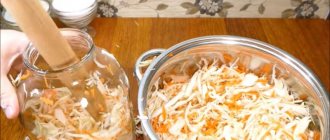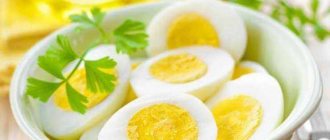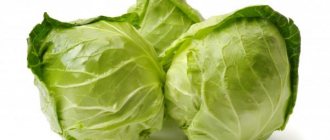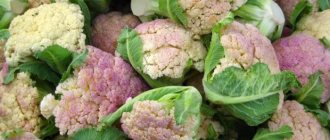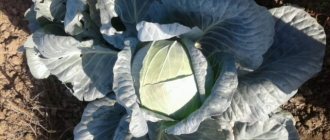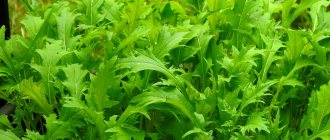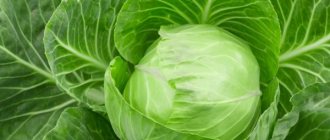The benefits of sauerkraut
Sauerkraut cannot be heat treated, so it retains vitamins and nutrients . It is usually fermented in the cold season, and it becomes a good addition to the winter diet, which contains practically no fresh vegetables.
This is interesting! According to one version, the name of this vegetable comes from the ancient Greek word “kaputum” and is translated as “head”.
In addition to excellent taste, the product has a number of additional beneficial properties.:
- during the fermentation process, the concentration of vitamin C increases in it;
- contains a large amount of vitamins (A, B, C, K) and minerals (manganese, copper, iron, magnesium, calcium);
- improves the functioning of the digestive system; strengthens the heart muscle;
- stimulates metabolism in the body;
- has low calorie content and can be used in the diet during a diet;
- strengthens the nervous system;
- prevents the occurrence of cancer;
- is an effective anthelmintic;
- improves skin condition;
- lowers cholesterol levels;
- eliminates toothache;
- contains lactic acid, which protects the body from germs and bacteria;
- helps fight depression and stress.
Nutritional value of the product
Sauerkraut has high nutritional value , since it is this method of preparation that retains the maximum amount of nutrients.
In addition to a large amount of vitamins (A, B1, B2, B5, PP), 100 g of the product contains :
- proteins - 1.6 g;
- fats - 0.1 g;
- carbohydrates - 5.2 g;
- dietary fiber - 4 g;
- starch - 0.2 g;
- ash - 0.9 g;
- organic acids - 79.2 g;
- mono- and disaccharides - 5 g;
- saturated fatty acids - 0.009 g.
This is interesting! Traditional medicine attributes truly healing properties to sauerkraut. Traditional healers recommend using the fermented product and its juice for literally any disease, from a common cold to such serious diseases as epilepsy and bronchial asthma.
How to remove bitterness from cabbage: varieties and features
Healthy, juicy, light, crispy - white cabbage is used as a base for many hot and cold dishes.
But it happens that the vegetable turns out to be overly bitter. What is the reason for this phenomenon?
https://www..com/watch?v=7WKnUsvZCgw
Why is cabbage bitter?
The presence of an unpleasant wormwood taste depends on several factors:
- unripe vegetables;
- violations of agricultural technology during cultivation;
- dry summer;
- a large number of chemical growth stimulants.
Let's look at each case separately and try to correct the situation.
Nitrates
The first cabbage harvest of the season suffers from an excess of nitrates, because its production is quite expensive.
It is necessary to heat the greenhouses, light them, and provide the plants with the required amount of nutrients and watering. Therefore, unscrupulous farmers intensively “feed” the seedlings with a mass of nitrogenous substances, which guarantee rapid leaf growth.
In this case, it is impossible to correct the situation - nitrates do not leave the product even during heat treatment. Therefore, when buying early cabbage at the market, you should tear off a small piece and chew it, of course, with the permission of the seller.
Features of the variety
It’s another matter if bitterness is a feature of a particular variety. In this case, you can correct the situation as follows:
- Shredded shavings from a young vegetable should be lightly salted and pressed a little with your hands. Set aside; when the cabbage releases juice, drain it;
- The prepared pieces can be sprinkled with lemon juice and added to the salad. The combination of acid and olive or any other oil perfectly removes the wormwood taste;
Immerse the prepared cabbage in boiling water for a few seconds and then quickly plunge into ice water to stop the cooking process. This option is especially good for small children. One minus is that during heat treatment some of the vitamins will be destroyed.
Unripe heads of cabbage
In late varieties of cabbage, unripe heads of cabbage may taste bitter. Therefore, put it away for storage only after the first frost. All unpleasant substances are concentrated in cruciferous plants in the seals and the stalk itself, so in varieties with such a defect these places should be removed.
Little secret. My family loves stewed cabbage. On most cooking sites, it's simply topped with tomato sauce and put on the stove. I crush the pre-salted chips a little and lightly fry them in a dry frying pan. There is no bitterness or unpleasant odor left in the pieces.
When a bitter taste spoils your sauerkraut, it means you prepared it incorrectly. During the fermentation process in vegetable pickling, gases are formed that must be released by piercing the cabbage mass with a wooden stick. And be sure to remove the foam that actively forms on the surface of the bucket or barrel during the first week of fermentation.
Cauliflower
This type of vegetable becomes bitter only if the head is overgrown or has been stored in the wrong place for a long time. Moisture gradually leaves the inflorescences, and the juice in the vegetable becomes concentrated.
To remove bitterness from cauliflower, you can:
- Place in cold, lightly salted water and place on the stove. As soon as the liquid boils, drain
- first decoction and pour clean boiling water. Then cook according to the recipe;
- disassemble the flowers into inflorescences and soak for at least half an hour in cold water acidified with lemon;
- pre-boil in water with added milk or in whole cow product;
- Place the cabbage, disassembled into florets, into the freezer for an hour or two. After sub-zero temperatures it never tastes bitter.
Naturally, none of the above methods will help against pesticides and nitrates.
Brussels sprouts
This vegetable has a wormwood taste regardless of how it is grown, which is why children do not really like it.
I adapted to making these little heads edible very simply:
- I remove the top leaves, carefully cut the stalks crosswise with the tip of a knife;
- I immerse the heads in salted boiling water for a minute;
- I take the hot Brussels sprouts out of the pan with a slotted spoon and place them in ice water.
Then I throw the vegetables into a sieve, let the liquid drain and cook as I want - stew or fry in batter.
Before removing bitterness from cabbage, be sure to have the vegetable analyzed in the nearest laboratory or using a portable device - excess chemicals in the diet of children and adults can lead to dire consequences.
Loading…
Basic rules for pickling cabbage
To make the snack tasty and retain the maximum amount of beneficial properties, you need to choose the right main ingredient and correctly carry out the salting procedure.
Preparation of sauerkraut is carried out according to the following rules :
- Rinse the vegetable in cold water and let the head of cabbage dry from moisture.
- Before salting , peel the vegetable from the top leaves and cut out the stalk.
- Cut the head of cabbage into 4 parts and finely chop each of them with a knife into strips 0.5 cm wide, so that the pieces of the vegetable are better saturated with salt, but remain crispy.
- Mix cabbage with salt in a wide bowl to ensure even distribution of salt throughout the mixture.
- During the mixing process, it is recommended to slightly press the mass with your hands to stimulate the formation of a sufficient amount of juice.
- For pickling, you need to use a clean container of a suitable size that does not have any foreign odors. Glass jars are best suited for this purpose.
- place the chopped vegetables in jars in layers and compact each of them tightly with your hands.
- When the jar is almost completely filled (2-3 cm left to the top), you need to cover the neck of the jar with a plastic lid, leaving an opening for air access.
- on the top layer of cabbage in a jar - a glass of water or a large apple.
- During fermentation, the jar of pickles should be in a warm room with an air temperature of about +18...+20 °C. This process takes about 3–5 days.
- As fermentation proceeds, foam will form in the container, which must be skimmed off.
Important! You need to take the sauerkraut to a cool place only after the fermentation process is over and foam stops forming in the jar of pickles.
To achieve a taste without bitterness, you do not need to deviate from the chosen cooking recipe, follow the advice and study possible mistakes in advance to prevent them.
For the “original” recipe you will need : fresh cabbage, beets, carrots, sweet pepper, garlic, dill, salt.
The recipe with the addition of bay leaves requires the following ingredients : cabbage, carrots, bay leaf and salt.
To prevent possible bitterness, preparation is as follows::
- Finely chop the cabbage and other vegetables with a knife or a specialized grater.
- Place in a bowl or large bowl. In this case, each layer must be sprinkled with table salt.
- Next, mix the contents of the container with your hands , kneading and pressing the cabbage.
- If necessary, other spices are added and the mixture is further stirred.
- The next step is transferring it into pre-prepared jars and sealing them.
Important! Recipes often use ingredients such as apples, cranberries, and honey. Sauerkraut is eaten as a salad with various side dishes. Used as a filling for pies and dumplings. Add to other salads in addition to eating as a separate dish.
What can cause bitterness in a dish besides a Chinese vegetable?
Chinese cabbage is stewed and boiled, used in salads and soups along with other vegetables, spices and fruits. Chinese cabbage has an unforgettable light taste.
Attention! The bitter taste of some vegetables and seasonings is natural. If a dish with the addition of Chinese cabbage tastes bitter, then perhaps radish or horseradish, mustard or grapefruit gives this piquant taste to the food. The list of truly bitter foods goes on.
What if the bitter taste in the dish was not included in the recipe? It happens that some vegetables acquire an unusual bitter taste. It can appear due to onions or lettuce, spinach, and other varieties of cabbage, such as Brussels sprouts or kohlrabi. For example, there are some varieties of lettuce that are bitter on their own. The record holder for bitterness is an ordinary fresh cucumber.
Sometimes the bitterness in a salad to which Pekin is added may appear only the next day.
Chinese cabbage is a tasty and healthy product that adds variety to our table. To understand that the cabbage is spoiled, carefully inspect it:
- Is it properly sealed in cling film, is there any damage?
- Is there rot on the leaves or are there any traces of insect activity or bruising?
- The forks of the plant should be evenly colored on all sides, tight and dense.
- The head of cabbage must be healthy, undamaged, unwashed, dry, and cleared of damaged and weak leaves. If it gets too wet, it will quickly rot.
For eating, it is better to choose cabbage that is slightly flattened on top. If the stalk has a crack at the cut site, the cabbage will be juicy and not bitter.
Bitterness in Chinese cabbage, unlike cucumbers or lettuce, is an unpleasant but rare occurrence. Methods for eliminating it are not complicated. Do not deprive yourself of the pleasure of pampering yourself with a dish of juicy and healthy Beijing!
If you find an error, please highlight a piece of text and press Ctrl Enter.
Cooking tips
The process of fermenting cabbage is not overly complicated if you adhere to the rules listed above. But besides this, there are a few more tricks that will help make the snack tasty, crispy and healthy.
Important! It is not recommended to rinse finished sauerkraut with water. This will make it soft and lead to the loss of all nutritional properties.
Let's look at a few tips for making sauerkraut :
- It is recommended to use regular table salt for pickling, as iodized salt will give an unpleasant salty taste;
- It is best to ferment vegetables in 2 or 3 liter glass jars so that the product does not have time to deteriorate;
- When preparing the snack, use the amount of salt specified in the recipe;
- to prepare sauerkraut, you can use glass, wooden or enamel containers, but fermenting vegetables in a plastic container or stainless steel container is not recommended;
- you should start fermenting cabbage in mid-autumn;
- if a fresh vegetable initially has a bitter taste, it is recommended to first soak it in cold water and only then use it for pickling;
- in addition to salt, carrots, horseradish, pepper and other spices are often added to the product;
- if you add grated carrots to the appetizer, the cabbage will turn a light pinkish color;
- to prevent the growth of bacteria, it is recommended to smear the walls of the container with honey before placing cabbage in it;
- to combat mold, it is recommended to put horseradish leaves in a jar with cabbage;
- You need to make sure that there is enough brine in the container and that it completely covers the vegetables.
Why is this happening?
Chinese cabbage is an early ripening, dietary and medicinal product. Crispy, juicy leaves do not become rough for a long time as they grow. In the heat, with a moderate lack of moisture, they do not accumulate bitterness, they do not contain calories and are pleasant to the taste. Why is Beijing (Chinese) cabbage bitter in salad?
The main reasons for the bitterness of Chinese cabbage:
- An unpleasant taste sometimes appears due to errors in cabbage growing technology.
Reference! Bitterness can occur if the harvest date is missed, the plant has already released a flower arrow. - In very dry and hot summers, if the plant grows on the sunny side all the time. If there is no regular watering, at least two or three times a week. Due to so-called plant stress.
- It happens that low-quality goods end up on the shelves for sale; excess nitrates accumulate in the green mass of Chinese cabbage. Typically, it is a sulfur-containing substance. The presence of chemical compounds gives a bitter taste to the tender leaves of the pekina.
- Sometimes bitterness is a feature of the variety (hybrid). Early varieties of cabbage, such as the Khibinskaya variety, which are grown in open beds, ripen in 40–45 days and usually do not have a bitter taste.
- Improper storage or transportation. Vegetables may have been defrosted during storage. Rot appeared on the leaves, but the cabbage still went on sale.
We invite you to familiarize yourself with: Kakadu pepper, a highly productive sweet variety
Why is it bitter?
Bitter sauerkraut can result from errors in choosing the main ingredient or from improper preparation of the dish. In this case, the fermentation process is not carried out actively enough and this leads to the proliferation of harmful microorganisms, which cause an unpleasant bitter taste in the finished product.
Let's look at the main reasons for the bitter taste in finished snacks and figure out how to eliminate them.
Ignoring piercing when salting
An unpleasant bitter taste may appear in sauerkraut if it has not been pierced during fermentation. During the interaction of vegetable juice with salt, a special acidic environment is formed inside the container .
As a result of the fermentation process, gases are formed that cannot leave the container on their own. Accumulating in the product, they cause an unpleasant odor, which also affects the taste of the vegetable, so the pickle acquires a bitter aftertaste.
To prevent the occurrence of bitterness, it is recommended to carry out the following actions:
- Before cooking , pierce the head of cabbage in several places with a sharp wooden stick to release carbon dioxide.
- During the fermentation process, pierce the mixture in the jar with a wooden stick to the very bottom so that carbon dioxide does not accumulate and escapes. Repeat this procedure 2 times a day.
- After placing the shredded cabbage in the jars, you can immediately insert a wooden stick in the center of the container - it will absorb the unpleasant odor and prevent the occurrence of bitterness.
This is interesting: We prepare delicious snacks for the winter: sauerkraut in its own juice and other recipes for healthy preserves
If these recommendations are followed, the resulting carbon dioxide will escape and will not affect the taste of the finished product.
Large amounts of salt
The bitter taste of pickles can be caused by excess salt . At room temperature, the fermentation process begins in finely chopped and tightly packed cabbage mixed with salt.
It is the result of the vital activity of lactic acid bacteria, which are formed as a result of contact of vegetable juice with salt. But with an excess of salt, lactic acid bacteria slow down their vital activity and partially die , and the fermentation process slows down. As a result, the characteristic foam does not form in the jar of pickles, the taste of the vegetable deteriorates, and its color becomes gray.
On a note! Just 100 g of fresh cabbage contains about 60% of the daily dose of vitamin C for an adult.
To fix the problem, you need to do the following::
- drain part of the brine from the jar and fill it to the top with clean cold water;
- if no more than 1–2 days have passed since pickling, you can add a small portion of fresh cabbage to the pickle, mix and put it back in a warm place to ferment;
- if oversalting was noticed a long time after putting the mass into jars, you can use the oversalted product to prepare cabbage soup, borscht or as a filling for pies.
Not enough salt
The bitter taste of cabbage may be caused by a lack of salt used for cooking. An active fermentation process is possible only when the vegetable juice interacts with salt in a warm room.
, the necessary environment in which beneficial lactic acid bacteria multiply does not form inside the container Instead, heat causes harmful bacteria to multiply in the cabbage, causing the product to rot.
Signs of a lack of salt in a jar of pickles are::
- gray color of vegetable pieces;
- cabbage becomes soft;
- the snack does not taste salty;
- the appearance of an unpleasant odor;
- the mass in the jar becomes covered with a slimy coating.
If the problem was noticed at an early stage of preparation, you can make up for the lack of salt in the jar. To do this, you need to drain part of the brine and add fresh salty solution to the container to stimulate the onset of fermentation.
If a lack of salt was noticed a few days after preparing the snack and the vegetable had time to become soft and slimy, then it will no longer be possible to save the pickle. In addition to unpleasant bitterness, such a dish can cause poisoning in the human body.
Important! In a standard sauerkraut recipe, for every 10 kg of vegetable you need to use 200 g of salt.
Do not use oppression or choose light oppression
The pressure is applied so that the cabbage releases more juice for the brine . Its other purpose is to reduce the amount of air in which harmful bacteria live. Without pressure, the product may deteriorate.
Cannot withstand temperature and fermentation time
Fermentation takes place in three stages:
- Reproduction of lactobacilli : at temperatures from +17°C to +24°C for 2-3 days. The brine becomes cloudy, foam and gas bubbles appear on the surface.
- Formation of lactic acid : 5-7 days at temperatures up to +20°C. It inhibits the growth of microorganisms, and after fermentation is complete, no gases are released from the cabbage.
- Post-fermentation : in the refrigerator for several months. In a warm place, mold grows and the dish spoils.
Due to overexposure at the first stage, transparent mucus forms in the cabbage - the result of the proliferation of lactobacilli.
Important! Exceeding the temperature during the fermentation stage leads to the growth of harmful bacteria and fungi. The cabbage darkens and becomes inedible.
If the product is put into the refrigerator before fermentation is complete , it will have an unpleasant odor of lactic acid.
Unsuitable variety for pickling
For pickling, you can only use cabbage of medium and late ripening varieties . Early vegetables have heads that are too loose, and the leaves are thin and green. They are good for making fresh salads, but contain little sugar and become bitter during fermentation.
Dense white heads of cabbage, which accumulate a lot of sugar during the ripening process, are more suitable for pickling . It is thanks to this that the juice of vegetables, which is released during the fermentation process, has a sweetish taste and, in combination with salt, makes the finished snack especially tasty.
These varieties are best suited for pickling:
- Moscow late;
- Valentina F1;
- Kharkov winter;
- Belarusian;
- Present;
- Glory;
- Atria F1;
- Megaton F1.
Incorrect timing of cutting during cultivation
Sometimes the bitter taste of sauerkraut appears as a result of the fact that it was cut from the garden at the wrong time. To prevent the vegetable from developing bitterness during pickling, it must be fully ripe .
Here are a few rules for choosing a suitable head of cabbage for pickling :
- It is recommended to cut the vegetable no earlier than 2 days after the first frost, since it is by this moment that it fully ripens;
- the cabbage should be firm and crack slightly when you press it with your hands;
- the head of cabbage should be white, this indicates that there is enough sugar in the leaves of the vegetable;
- the stalk should be juicy and dense;
- After cutting, the head of cabbage needs to lie down for another 1–2 weeks to finally gain maturity.
Iodized salt is used
Iodine is an active chemical element - under its influence, cabbage darkens and softens .
What needs to be done to eliminate the unpleasant taste?
If the plant has bitter leaves, then you can remove the unpleasant taste using one of the following simple methods:
Take a head of cabbage and place it in a wide and deep container (bowl or pan) filled with water and salt. The water should be cold. You can add ice for extra cooling. Dip the Peking forks into the water and let it stand for half an hour. Then the cabbage should be pulled out and laid out on a towel to drain the water.
- Boil the cabbage forks over low heat for a short time, no more than two minutes.
- Sprinkle Chinese cabbage generously with lemon juice. Or soak in water with vinegar or citric acid.
- Carefully chop the cabbage, mash it by hand, add salt, then mash it again. Let it sit for a few minutes so that it releases the juice. Drain the juice.
- You can also prevent bitterness by preparing a dish with Chinese cabbage for one meal. Leaving cabbage the next day can cause bitterness.
Important! When boiling and soaking, vitamins (ascorbic acid) and other useful substances also get into the water with bitterness. Cabbage is no longer bitter, but it has fewer health benefits.
It may be bitter due to the fact that it was not pierced and salted. As soon as the fermentation process begins, gases begin to form in the cabbage, which do not have the opportunity to independently escape from the depths of the container in which it is fermented.
It is necessary to help her with this, piercing with a wooden stick with a sharp end. This should be done, reaching to the very bottom, several times a day. You need to stop when the cabbage has fermented.
Of course, this is not news for those people who make sauerkraut every year. But it will be very helpful for beginners. Cabbage contains bitterness, which goes away with gases during fermentation.
Bitterness may come from salt. When fermenting, you should use regular table salt. Some take iodized, thinking that they do better, but not in this case. After pickling, it is not recommended to immediately take the cabbage out into the cold. It must be kept warm to ferment well. After removing the foam, take it out into the cold.
Another reason may be insufficient salt. In the classic recipe, 200 grams of salt are used for 10 kilograms of cabbage.
It may be that the variety is not suitable for pickling. For this purpose, cabbage varieties need to be taken late. For example, very good varieties “Slava”, “Moskovskaya late”, “Kharkovskaya zimnyaya”, “Geneva f 1” and “Valentina f 1”.
A very important point is the time of cutting the cabbage. It must be cut two days after the first frost hits. If you cut it early, it will become bitter when salted, as it has not been aged. Even after cutting the heads of cabbage, it is not salted early. She needs to lie down and gain maturity.
It may be bitter for a simple reason: it is not ready yet. The salting process is not completed. It's easy to find out. Look at it, if the cabbage is white in color it is definitely not ready. It should be slightly transparent and slightly grayish. At the beginning of salting and at the end, the color and taste are very different.
We invite you to read: The easiest way to pickle cabbage for the winter
The cause could even be the barrel or container in which you salt the cabbage. Many people use three-liter glass jars. This is a very good option. The problem with storage disappears by itself. And it doesn’t become soft - it just doesn’t have time!
You can do it throughout the winter. As soon as you want. Only by April the cabbage heads become a little dry. When salting, there is not enough juice released. In this case, the top layer in the bottle just needs to be removed.
How to get rid of bitterness
Removing the bitter taste from finished sauerkraut is difficult and does not always work . You should try to take all possible measures to prevent the development of bitterness during fermentation.
The easiest way is to familiarize yourself with the rules for fermenting cabbage before preparing it to avoid an unwanted bitter taste . But if for some reason the finished product still has a bitter taste, then you can try to eliminate it with the help of small tricks.
This is interesting! Sour cabbage began to be prepared in China back in the 3rd century. BC e., soaking the vegetable in wine for several days.
Let's look at the main ways to correct mistakes and get rid of bitterness in the finished product :
- You need to remove the “lid” from the container where the cabbage is located . Next, pierce the mixture about 10 times with a wooden stick. Excess gas will be released, which will eliminate the bitter taste. After the procedure, the jar is placed in a cool, dark place. It is advisable to get rid of gas several times during fermentation.
- It is also possible to immediately place a wooden stick in the center of the container, which will absorb the unpleasant taste.
- Place the pickle on a plate and let it air for some time. To improve air circulation, the product must be stirred periodically.
- Prepare a pickled appetizer from bitter sauerkraut . To do this, you need to squeeze the juice out of it, and then add a little sugar and vinegar, onion half rings and vegetable oil. The resulting mixture is placed in glass jars and stored in a cool place.
- Use bitter sauerkraut for making cabbage soup, stewing or frying. During the heat treatment, the bitter taste will completely disappear.
- Drain all the juice from the container with the pickle and fill it with new brine made from water, salt and sugar. After this procedure, the snack will partially lose its aroma, but the unpleasant bitter taste will go away. To prepare a new brine, salt and sugar should be taken in equal proportions.
Advice! Before serving the cabbage, it is recommended to ventilate it, stirring it occasionally.
Causes of bitterness
The preparation acquires a bitter taste due to several reasons.
- During the fermentation period, a large amount of gas appears, which cannot leave the cooking container. To avoid the accumulation of gases, it is recommended to frequently pierce with a wooden stick; birch is most often used. If you neglect this method, the salad and brine will become bitter.
- Little salt added during cooking results in a bitter taste. There is no need to deviate from the standard recipe, calculating 0.2 kg of spice per 10 kg of vegetables.
- The appearance of bitterness in cabbage is facilitated by a violation of the required temperature regime when the room temperature exceeds 20 degrees Celsius.
- Incorrectly selected salt for sourdough. Be sure to use table salt. A common mistake is using iodized water.
- If you decide to eat the cabbage before it is cooked, the taste will differ from what was intended. Before opening, finishing the salting process, you need to check the appetizer for readiness. The finished product differs in color. The cabbage will be transparent and take on a grayish tint.
These errors during cooking can lead to spoilage of the finished product.
Preparing for storage until spring
Most often, cabbage is fermented in fairly large volumes .
In order to protect it from damage and preserve maximum nutrients, you need to pay attention to a number of points .
Among them:
- choice of variety and heads of cabbage;
- correct salting technology;
- prevention of mold and drying of the top layer;
- selection of storage location and containers;
- maintaining the necessary storage conditions.
Preventing Mold Formation
A white coating on the surface of some workpieces is associated with the appearance of fungus. Even when removing it, you cannot be completely sure of the safety of the product .
The following techniques will help you avoid mold::
- Sprinkle grated horseradish on top of the packaged cabbage.
- Add sugar or mustard powder.
- When fermenting, add lingonberries or cranberries.
- If you use mustard seeds , it is better to first put them in small canvas bags.
This is interesting: The best recipes for how to salt watermelons in a pan in slices, tasty and quick
Brine quantity: more or less
When storing cabbage, you should make sure that the entire preparation is covered with a layer of liquid .
Without brine, the top layer will turn dark and deteriorate . Organizing oppression can be a solution to a problem.
Preservatives for pickling: what to choose
Natural preservatives can ensure long-term storage of the product. They are used as follows :
- pour a little vegetable oil on top of the container with the vegetable - enough to just cover the cabbage;
- add just a little acetic acid;
- when fermenting, you can use more salt;
- Sprinkle the top of the compacted dough with sugar.
Natural products that are safe for health can give a good canning effect.
Reviews
Every year I pickle cabbage in three-liter glass jars, and the finished cabbage never tastes bitter. I remember to remove excess gases and always follow my old recipes. Guests and relatives all say that the cabbage turns out delicious.
Anastasia, 67 years old.
Every year I cut down all the heads of cabbage before frost, they say that this affects its taste. If I don’t have time, then I try to remove everything on the first day of frost. I monitor the fermentation process carefully; before serving, I always check to see if it’s ready. It usually turns out delicious, but if it’s a little bitter, I use it for borscht and cabbage soup.
Storage location for fermented product
It is believed that a suitable place for storing sauerkraut and other pickles is a cellar or basement . This is due to the fact that in the basement the temperature regime is optimal for maintaining the freshness of such products.
Also, sunlight does not enter the underground, contact with which is contraindicated for pickles , since under the influence of ultraviolet radiation they begin to rapidly deteriorate. In addition to the above, in a good cellar or basement, air humidity levels are optimal for keeping pickles fresh.
However, there are also negative aspects of storing sauerkraut in the basement . So, if pickles are kept underground, the likelihood of mold developing is higher. And you cannot send sauerkraut to the basement or cellar in the case of an apartment. In this situation, a glazed balcony, loggia or refrigerator is a good place to store pickles.
also acceptable to keep sauerkraut in a cool pantry . At the same time, in a warm room, where the temperature is above +18˚ C, the product is added in portions - one time at a time. The remaining cabbage, if the entire volume brought was not eaten immediately, is not put back into the brine - it is stored separately from the main volume of the workpiece, in the refrigerator.
Cellar storage
Pickles can be stored underground for a long time, especially when the sauerkraut is placed in glass jars , which are sealed with metal lids. However, you cannot completely fill the jar with the product - there should be no contact of the pickle or brine with the metal.
In the autumn-winter season, as well as at the beginning of spring, sealed jars will well maintain the freshness of the product . But, with the onset of summer, the maximum shelf life of sauerkraut is approximately 1 month, since the temperature in even a well-buried underground does not drop below +7˚ C.
In addition to sealed jars, pickling can be stored in enamel buckets or pans , the lids of which fit tightly. If there is no lid, then they make a squeeze - a plate or lid is placed on top of the product, which will press the pickle due to a jar of water placed on top.
also acceptable to keep sauerkraut in ceramic barrels, but it is important to check that the container is clean . In the case of wooden utensils, no foreign odors should come from them, as the pickling will absorb them, which will spoil the taste of this product.
On a note! When storing sauerkraut in an enamel bowl, it is important that there is no damage to the enamel, since the pickle will oxidize in case of direct contact with metal and its shelf life will expire faster.
In the apartment on the balcony
In apartment conditions, you can also choose a place to store sauerkraut, in which its shelf life will be as long as possible. Since there is no underground space, pickles are often sent to the refrigerator .
However, when a lot of sauerkraut is prepared, it is impossible to place its entire volume in the refrigerator. In this situation, the pickles are left on the balcony - if it is glazed and insulated enough so that there is no minus on it.
also permissible to send sauerkraut to an unglazed balcony, but in this case it is recommended to pack it in portions. This is due to the fact that in the case of sub-zero temperatures, the pickles will be frozen, and they cannot be exposed to this effect again.
Also, one must take into account that already frozen sauerkraut is worse and its maximum storage duration at a temperature of +1...+4˚ C does not exceed 1-4 days.
However, it is not recommended to leave pickles even on an unglazed balcony in the climate of the southern regions . This is due to the relatively mild winter, since the temperature on the street and, accordingly, on the balcony can increase to +7...+10˚ C.
This thermometer mark does not help increase the shelf life of pickles. At the same time, there is also no stability of temperature in winter - the thermometer mark changes from positive to negative values. Repeated freezing negatively affects the condition, consistency, taste characteristics and shelf life of sauerkraut .
Storage in plastic containers
When storing products prepared using the fermentation method, you can use polymer containers. But it is also necessary to take into account the characteristics of the composition and the shortened period. If there is no marking on the container, then there is a high probability of using melamine - such dishes are toxic. Plastic marked PP (PP - polypropylene) poses a low risk - dishes for feeding children and food containers are often made from this material.
Also, the following notes are suitable for storing pickled shredded cabbage leaves :
- HDPE (HDPE - low-density polyethylene);
- PET, PETE (PET – polyethylene refthalate);
- OTHER (Other - the mark in the form of a spoon and fork is important).
PVC containers (V, PVC - polyvinyl chloride) cannot be used for acidic workpieces - it is a toxic material that is applicable only for technical purposes. When freezing, it is strictly not recommended to use containers with MDV markings (LDPE - low-density high-density polyethylene).
You can put the sauerkraut in boxes marked as PS (PS - polystyrene), but we must not forget about the negative fumes when heating such containers.
On a note! When choosing high-quality plastic for food use, you can preserve pickles longer than in enamel containers. But, such containers must be tightly closed and kept in a cool place.
Storage in banks
Glass is one of the most inert materials, so long-term storage of an acidic product in such containers is possible . Containers made of this material must be checked for integrity before use, especially in the neck area. Glass jars, before placing shredded sheets in them, must be washed with a soda solution and sterilized with steam or heated in a convection oven.
Such containers must be closed with a thick polymer lid intended for preservation - they fit more tightly and must be heated before closing. You need to be careful when handling glass containers with the product - jars can easily be broken by accident. Also, when storing on the balcony for a long time, you need to take into account the temperature regime - if it’s frosty outside, it’s better to put the container with sauerkraut in a warm place.
Warm sauerkraut
Storing an acidic product in a warm room is doubtful, but possible . A tightly covered vessel with cabbage can be left in the kitchen or in a warm room, and it will not be immediately spoiled. But, to extend the shelf life and preserve the taste and beneficial components, it is necessary to update the brine with one of the main preservatives - sugar. It needs to be poured on top every 2-3 days.
Such an additive in the acidic environment of fermentation, under the influence of bacteria, is converted into acid . But, when stored in a warm place, be sure to monitor the general condition of the product and take into account the risks of mold development. When a dish is over-acidified, sugar can also correct the taste. On a large plate, just add 1-2 tsp. granulated sugar and mix thoroughly. It will not be possible to restore density this way, but the taste of the product will be normal.
Attention! It will not be possible to save pickles that already have mold in them - the fungi quickly spread their spores into the through space and such cabbage will simply have to be thrown away.
Ways to get rid of bitterness
- Heat treatment. Clean the forks and wash them well. Cut and boil for 10 minutes, drain. After this procedure, the taste will improve significantly, the bitterness will disappear.
- Salt. Finely chop the head of cabbage, sprinkle with salt and mix thoroughly. Allow time to stand for the juice to release. When it separates, drain well. Salt will help restore the pleasant taste. You can also ferment cabbage.
- Lemon juice. Another effective and simple way to combat bitterness is soaking in a solution of lemon juice.
All these options are suitable both for salads and for frying and preparing stewed cabbage.
That is, use it for different types of dishes, without any restrictions. You can watch videos with recipes on various websites on the Internet. The most popular cabbage dishes today are bigus, sauerkraut, vitamin salad, cabbage rolls, cabbage cutlets, etc. Cabbage is one of the vegetables that are cultivated by almost all summer residents. If you follow all agricultural practices and protect it from pests, the harvest will definitely be generous. But sometimes it happens that fresh cabbage has a bitter taste. This could be due to mistakes made during cultivation or the wrong choice of variety.
Fresh cabbage. The illustration for the article is used under the standard license dachnyedela.ru
Causes of bitterness in cabbage
Cabbage can taste bitter for a variety of reasons.
Cabbage contains glycosides that protect the vegetable from diseases. There are less of these substances in early varieties than in later ones. It is the latter that are stored and eaten in winter. Their heads of cabbage are denser, the leaves have a bluish tint. If you let the vegetable sit until February, this will reduce the concentration of glycosides. The best place to store the harvested crop is the cellar.
Sometimes the bitterness of cabbage is due to the fact that the summer resident grows it incorrectly. A deficiency of certain elements, just like their excess, can cause bitterness.
Irregular watering also negatively affects the taste of cabbage. If the vegetable is adjacent to hot pepper, the corresponding taste is ensured.
White cabbage. The illustration for the article is used under the standard license dachnyedela.ru
Harvesting must be done on time; you should not rush or delay, otherwise the taste of the cabbage will deteriorate.
How to remove bitterness
If fresh cabbage has a bitter taste, you can eliminate it in different ways:
- The leaves are poured with boiling water and kept in it for no longer than 1 minute.
- The vegetable is chopped and soaked in cold water for about half an hour.
- Cabbage is soaked in water with the addition of lemon juice.
- The vegetable is chopped, salt is added, mixed, allowed to stand, and then washed in cold water.
White cabbage is a healthy vegetable that is rich in vitamins and microelements. It must be included in the daily menu in order to saturate the body with valuable substances. To prevent it from becoming bitter, summer residents will have to adopt all the rules for growing it and select the appropriate varieties. If it is too late to change something, and the vegetable has an unpleasant bitter taste, you can correct the situation by soaking.
Sometimes housewives, when preparing vegetable dishes, are faced with the fact that cabbage grows. An unpleasant taste may be the result of improper heat treatment or growing technology. Let's look at the main mistakes that lead to product damage.
- Natural causes
- Errors in agricultural technology
- Which cabbage is bitter?
- Fresh
- Pickled and salted
- White cabbage
- Brussels and color
- Beijing and Chinese
- Iceberg
- Savoy and Red
- Broccoli
How to get rid of bitterness
Why is cabbage bitter and what to do about it?

